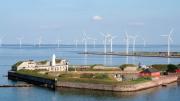As the Chinese, Spanish, Indian, and American governments subsidize the growth of wind technology as a source of renewable energy, they’re learning that breakthroughs in the field require more than money. “Unglamorous persistence,” instead, has produced the greatest results during the past 150 years, according to Straus professor of business history Geoffrey G. Jones. In the first of what he envisions as a series of papers on the origins of “green” industries, Jones focuses on the critical role of early inventors.
In “Historical Trajectories and Corporate Competences in Wind Energy,” he and research associate Loubna Bouamane track the history of green entrepreneurship in developing wind technology. The working paper focuses on the first turbine manufacturers, who pushed to make the technology more efficient and reliable, including a Scottish engineer who built a windmill for electricity production in 1887, a Danish teacher who experimented with a wind tunnel in 1891, and the Jacobs brothers of Montana, who used turbines to bring electricity to remote farms across the upper Northwest during the first half of the 1900s. The authors note differences between the work of these innovators, who sought to solve problems of power scarcity, and the origins of the oil and gas industries, where development was driven by the presence of abundant natural resources that could be brought to market for profit. Green innovators generally are less motivated by profit than by other considerations, Jones says. “You see entrepreneurs who imagine a world they see as not sustainable, that has huge problems, and they set about doing what they do, which is entrepreneurship to change that world.”
The paper also covers the effects of public policy, which varies in effectiveness by country. In general, renewable energy has not yet emerged as a profitable energy source, Jones explains, so it still needs to be buttressed with government subsidies. His research suggests that “the striking thing about wind energy—even solar energy, for that matter—is that it’s the story of incremental improvement: experiments and decades, really, where there’s not that much money to be made.” Thus government-sponsored efforts to purchase power from providers—known as feed-in tariffs—are integral to encouraging the technology’s growth. Denmark’s embrace of wind energy in the 1970s, coupled with plenty of wind and the entrance of heavy-equipment manufacturers such as Vestas, Nordtank, and Bonus into the turbine-production industry have resulted in that small country’s ability to obtain nearly 20 percent of its electricity from turbines.
The Danish approach, Jones notes, contrasts with that of the United States, which sank more than $380 million into research to develop giant wind turbines beginning in the 1970s. Funding peaked during the oil shortages of 1979, as the U.S. government awarded contracts to the leading aerospace and technology firms Boeing, General Electric, and Westinghouse to build commercially viable, large-scale turbines that could rival other power sources. But the 15-year surge of spending from 1973 to 1988—like other government forays into green technology research and development—came up empty, hitting what Jones labels a “technological dead end.”
Meanwhile, government operating subsidies dating back to the early 1980s help explain why large corporations like General Electric, Siemens, India-based Suzlon, and many Chinese firms dominate turbine production, and thus the industry, today. Even Enron, an energy-services company, jumped into the business: its sales of wind turbines, which “provided a veneer of respectability for a company engaged in increasingly illegal practices,” says Jones, rose from $50 million in 1997 to $800 million in 2001 (the year it went bankrupt while facing investigations into accounting fraud).
Jones sees the ups and downs of the wind-energy business, from entrepreneurial origins to government subsidization, within a larger context of the rise of green businesses in multiple industries, including organic food, solar energy, sustainable agriculture, and ecotourism. (Working papers focusing on solar energy and on organic agriculture and natural food are scheduled for publication later this year.) Research for Beauty Imagined, his 2010 book on the history of the global beauty industry, made him aware that “natural” cosmetics producers had been exploring the idea of developing beauty products without synthetics “at a time when nobody else did, and they were regarded as complete lunatics and struggled for decades to make a profit.” He suggests that wind energy’s analogous rise has been ignored to this point because histories of renewable energy have largely ignored the entrepreneurs introducing the technology: “There’s been this general assumption that the rise of wind energy is a story about government, not business.” Instead, he says, his research is documenting that entrepreneurs and government leaders need to work together to foster practices of sustainable living and promote the industries that make it possible to “live green.”
Geoffrey Jones website:
https://drfd.hbs.edu/fit/public/facultyInfo.do?facInfo=ovr&facId=24276











